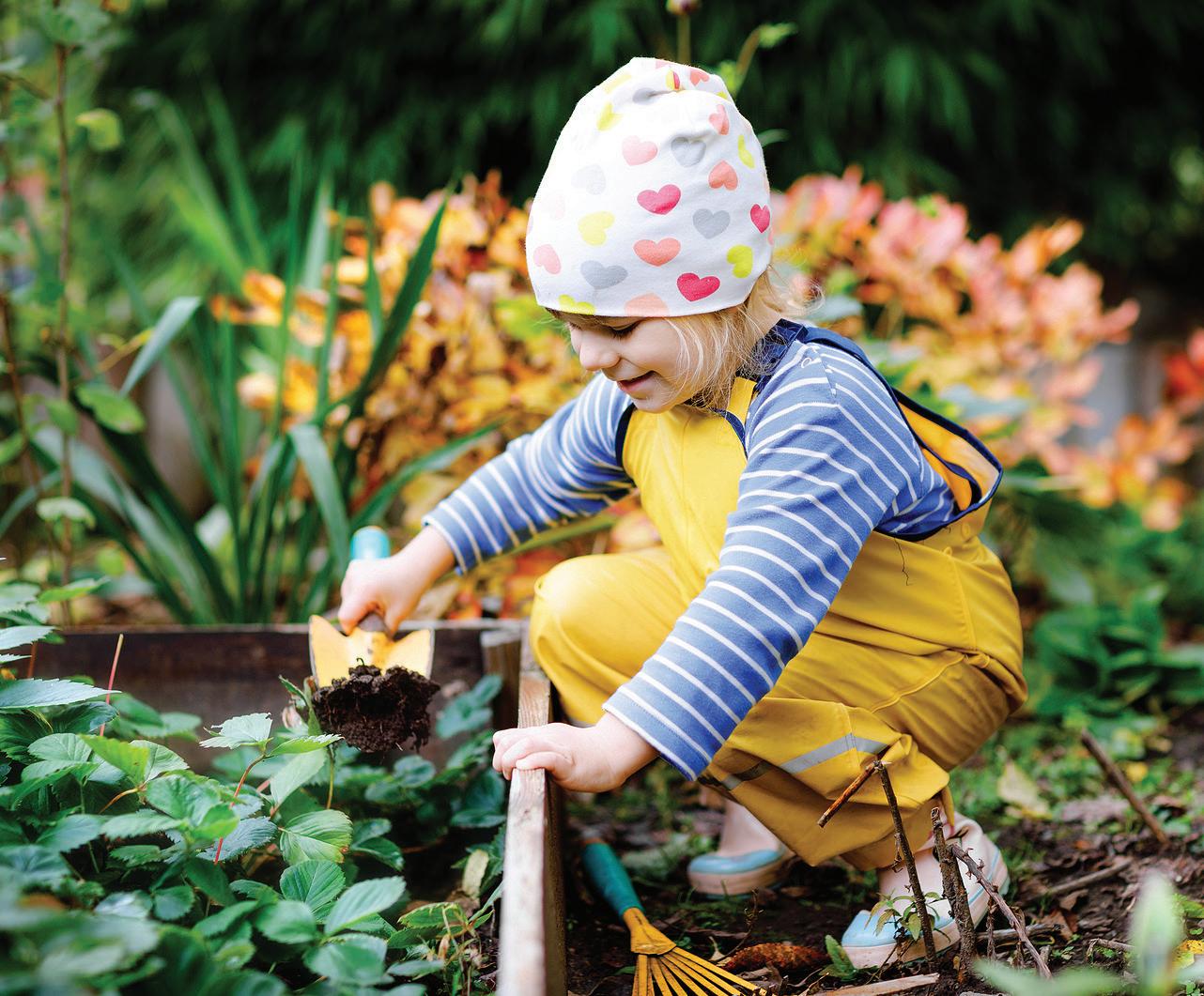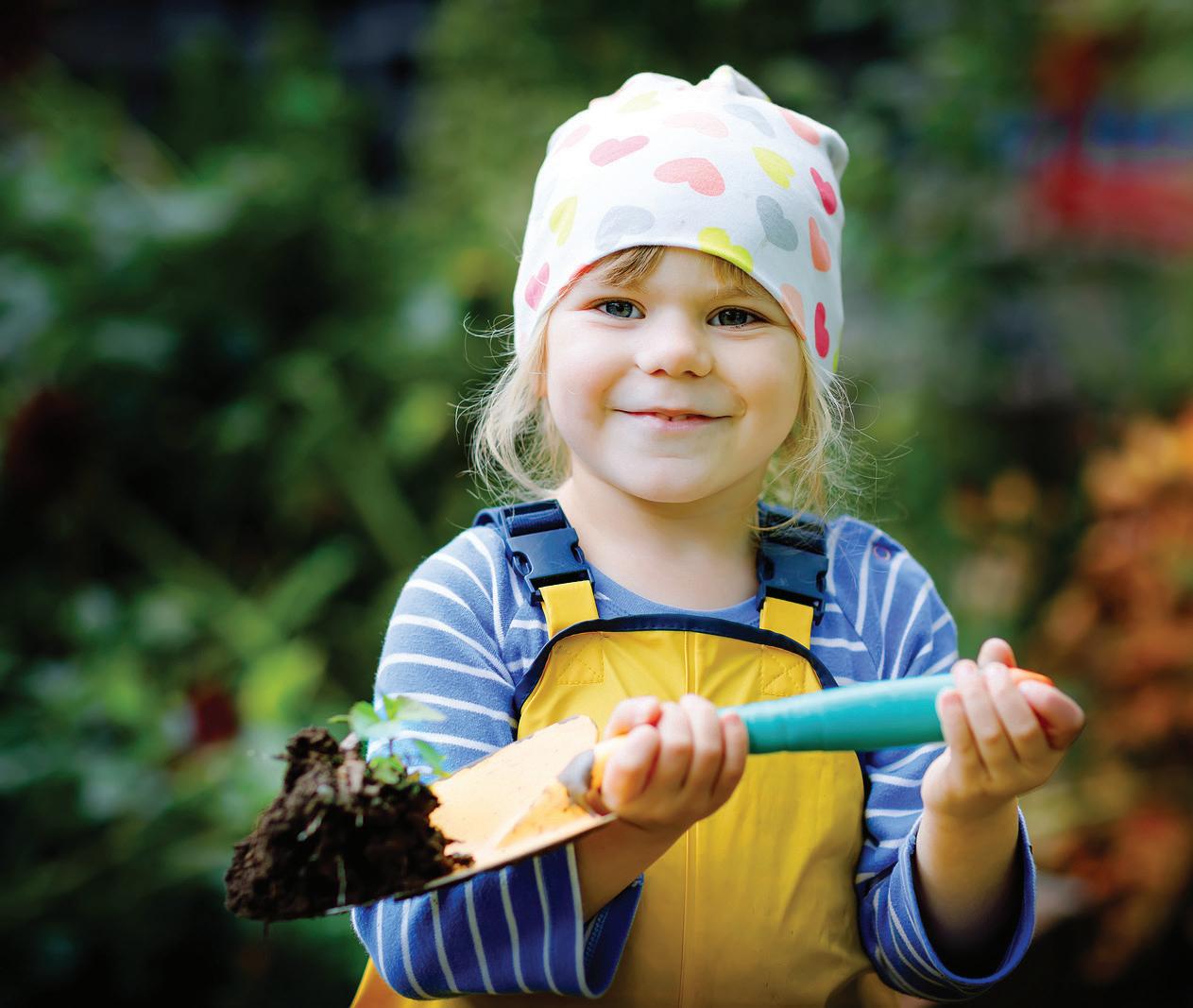
6 minute read
10 Big Benefits of Gardening With Kids
Dig This: 10 Big Benefits of Gardening With Kids
By Janeen Lewis
Advertisement
Most parents want their children to get outside away from phones, TV, and video games. Gardening is a great way to achieve this goal. However, recent research shows that there are several other reasons to start a garden with kids. The benefits range from making kids smarter to making them healthier. Here are 10 great reasons to get kids gardening:
1. Students who garden score higher on science tests.
Gardening is full of science. Children learn about plant classification, weather, soil, and plant pests, and disease. They are introduced to botany in a natural, handson way, and recent research shows that students who had gardening experiences as part of their school curriculum did better on standardized science tests than students who were not exposed to gardening in school.
2. If they grow it, they will eat it.
As a teacher, I’ve taught STEM (Science, Technology, Engineering, and Math) and have served as a Junior Master Garden club leader. In these roles, I witnessed the “if they grow it, they will eat it” phenomenon. Students love to dig up what they have grown, and then curiosity gets the better of them – they want to taste it. Master Gardener Beth Tovi has volunteered to mentor students in the garden for eight years at the elementary school where she has served as a media specialist. She sees the nutritional and health benefits children gain from gardening.
“With the growing concerns about obesity, diabetes, and even high blood pressure in children, gardening gets them physically active and outdoors. And children will eat anything they grow – even if it’s green.”
3. Digging in the dirt can make kids healthier.
Several studies show that children who were raised on farms don’t have as many respiratory allergies, asthma, or autoimmune disorders as children who were raised in urban areas because children who live on farms are exposed to more microbes and fungi in the dirt. Letting children get outside and get in the dirt may actually make them healthier than keeping them tidy, clean, and inside.
4. Gardening strengthens emotional and interpersonal skills.
Children who garden learn responsibility, patience, perseverance, and how to deal with disappointment if the garden doesn’t grow the way they expected. How do they collaborate with other siblings, friends, or school mates to get the garden work done? These are character-building skills that research shows children reap in the garden. I witnessed this one year at a school garden when we had a drought. Watering the plants and trying to keep them healthy was an arduous task, and the students and I learned about perseverance and teamwork.
5. Gardening connects children with nature.
When children garden, they gain ownership in what they are cultivating. I have seen my own children grow “attached” to the plants in the containers on our patio garden. As children become more knowledgeable about all the living things in the garden, they are less likely to be afraid of touching the plants, getting soil on their hands, or being near bugs. They are no longer afraid of the unknown when they become familiar with what is in the garden.
6. Gardening helps relieve stress for the whole family.
A garden can be therapeutic. Not that your fourth grader is battling traffic, raising children, and feeling the demands of a pressure-ridden job, but even kids can feel stress, and the garden is good for eliminating it. In fact, a study in the Netherlands showed that after 30 minutes of gardening, subjects who had shown stress before they gardened had a “fully restored” positive mood. And if the adults in the family are feeling stressed, and they garden with their children, it can help the whole family feel more harmonious.
7. Gardening teaches kids to problem-solve.
“When they garden, children learn problemsolving skills,” Tovi says. “They say ‘This trellis doesn’t work very well. How can we make one that will better support this kind of plant?’” In a garden, children ask questions like “What is eating this plant?” or “Is this tree dying?” Once children become absorbed in solving the problems in a garden, they want to research to find the best answers. “They become sleuths, starting in the garden and heading into the computers,” Tovi says.
8. Gardening is a good work out.
Gardening is good physical labor involving muscles that don’t always get a workout. Even the most seasoned gym-goer may admit to being sore the day after working in a garden. Gardening involves stretching, bending, digging, lifting, pulling, and raking. Gross and fine motor skills are used, and even the youngest gardener with simple tasks gets physical activity.
9. Gardening helps children become environmental stewards.
When children start reaping the food and flowers that come from a garden, they realize a garden’s impact on them and their impact on the garden. Once they have this tangible experience, it is much easier to teach them to care for the environment.
10. Gardening can lead to a longer life.
Studies show that adults who garden in their later years live longer. Instead of living a sedentary life, gardeners get off the couch and are active in nature. Teaching children good habits when they are young will make them more likely to follow them through life.
Sow the seeds of a garden with your child today, and see them reap the benefits for a lifetime.
Creative Theme Gardens to Grow with Kids These interesting themes are a great way to inspire children to garden.

Pizza Garden - Grow all the herbs to add to a pizza. For an extra touch, make the garden round like a pizza.
Fairy Garden - This garden includes both plants and miniature structures and is a great place for your child’s imagination to grow.
Pollinator Garden - Build a garden that attracts butterflies, bees, birds, bats, and other insects and animals that will help pollinate plants. Try planting milkweed, zinnias, and snapdragons.
Herb Garden - Herb gardens are a great way to foray into the world of gardening. They can be grown inside or outside and include plants such as basil, oregano, sage, thyme, parsley, and many more.
Art Garden - Students can grow flowers and plants that can be used to make art, or grow a garden of plants for kids to sketch.
Maze Garden - Create a maze with hedges, grasses, or corn. In the middle of the maze, put something interesting like a sculpture, fountain, or another special garden bed.
Peter Rabbit Garden - Grow the vegetables found in Mr. McGregor’s garden. The great thing about this garden is that you can grow some of the vegetables – carrots, lettuce, radishes, and cabbage – in cool weather, so you could continue to garden into fall. Wildflower Garden - Visit a nature preserve to discover the native wildflower plants in your area. Then, build a garden with those flowers. Three Sister’s Garden - Teach children about plants that grow well together, like corn, beans, and squash, by cultivating the three in one mound.
No Yard? No Problem!
When your backyard is a concrete patio or an apartment balcony, it is hard to imagine growing a bountiful garden. But it can be done in containers. Choose some eco-friendly containers with drainage holes in the bottom, fill them with a potting mix, and choose seeds or seedlings to plant.
Another option is to grow an herb garden inside on a sunny window ledge.
A great resource for starting a container garden is The Vegetable Gardener’s Container Bible: How to Grow a Bounty of Food in Pots, Tubs, and Other Containers by Edward C. Smith.
This book teaches even beginning gardeners how to grow organic food in small spaces. The book covers container and tool selection, caring for plants, and controlling pests without chemicals.
With a little research and tender care, you can grow flowers and vegetables that flourish.








